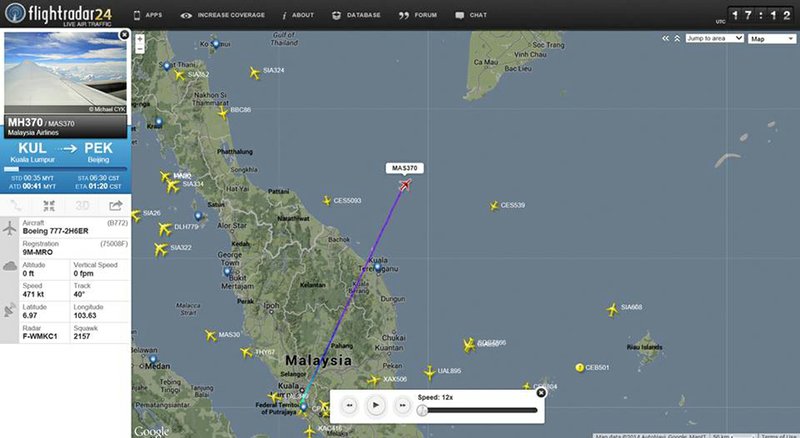KUALA LUMPUR, Malaysia — Vietnamese air force planes spotted two large oil slicks Saturday in the region where a Malaysia Airlines jetliner disappeared, the first sign that the Boeing 777 with 239 people aboard had crashed.
The air force planes were part of a multinational search operation launched after Flight MH370 fell off radar screens less than an hour after taking off from Kuala Lumpur bound for Beijing.
The oil slicks sighted off the southern tip of Vietnam were each between 10 kilometers (6 miles) and 15 kilometers (9 miles) long, the Vietnamese government said in a statement.
There was no immediate confirmation that the slicks were related to the missing plane, but the government said they were consistent with the kind of slick that would be produced by the two fuel tanks of a crashed jetliner.
After the oil was spotted, the air search was suspended for the night and was to resume Sunday morning. A sea search continued, the airline said.
The jet was believed to be flying at cruising altitude when it vanished.
Malaysia Airlines CEO Ahmad Jauhari Yahya said there was no indication the pilots had sent a distress signal, suggesting that whatever trouble befell the plane happened quickly, perhaps in a sudden catastrophe.
The plane was last inspected 10 days ago and was "in proper condition," Ignatius Ong, CEO of Malaysia Airlines subsidiary Firefly airlines, said at a news conference.
Two-thirds of the jet's passengers were from China. The rest were from elsewhere in Asia, North America and Europe.
Asked whether terrorism was suspected, Malaysian Prime Minister Najib Razak said authorities were "looking at all possibilities, but it is too early to make any conclusive remarks."
Contributing to fears of foul play was word from foreign ministries in Italy and Austria that the names of two citizens listed on the flight's manifest matched the names on two passports reported stolen in Thailand.
Italy's Foreign Ministry said an Italian man who was listed as being a passenger, Luigi Maraldi, was traveling in Thailand and was not aboard the plane. It said he reported his passport stolen last August.
Austria's Foreign Ministry confirmed that a name listed on the manifest matched an Austrian passport reported stolen two years ago in Thailand. It said the Austrian was not on the plane, but would not confirm the person's identity.
At Beijing's airport, authorities posted a notice asking relatives and friends of passengers to gather at a nearby hotel to await further information. A woman aboard a shuttle bus wept, saying on a mobile phone, "They want us to go to the hotel. It cannot be good."
Passengers' loved ones were escorted into a private area at the hotel, but reporters were kept away. A man in a gray hooded sweatshirt later stormed out complaining about a lack of information. The man, who said he was a Beijing resident but declined to give his name, said he was anxious because his mother was aboard the flight with a tourist group.
"We have been waiting for hours and there is still no verification," he said.
In Kuala Lumpur, family members gathered at the airport, but were also kept away from reporters.
The plane was last seen on radar at 1:30 a.m. (1730 GMT Friday) above the waters where the South China Sea meets the Gulf of Thailand, authorities in Malaysia and Vietnam said.
Lai Xuan Thanh, director of Vietnam's civil aviation authority, said air traffic control in the country never made contact with the plane.
The plane "lost all contact and radar signal one minute before it entered Vietnam's air traffic control," Lt. Gen. Vo Van Tuan, deputy chief of staff of the Vietnamese army, said in a statement.
